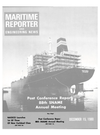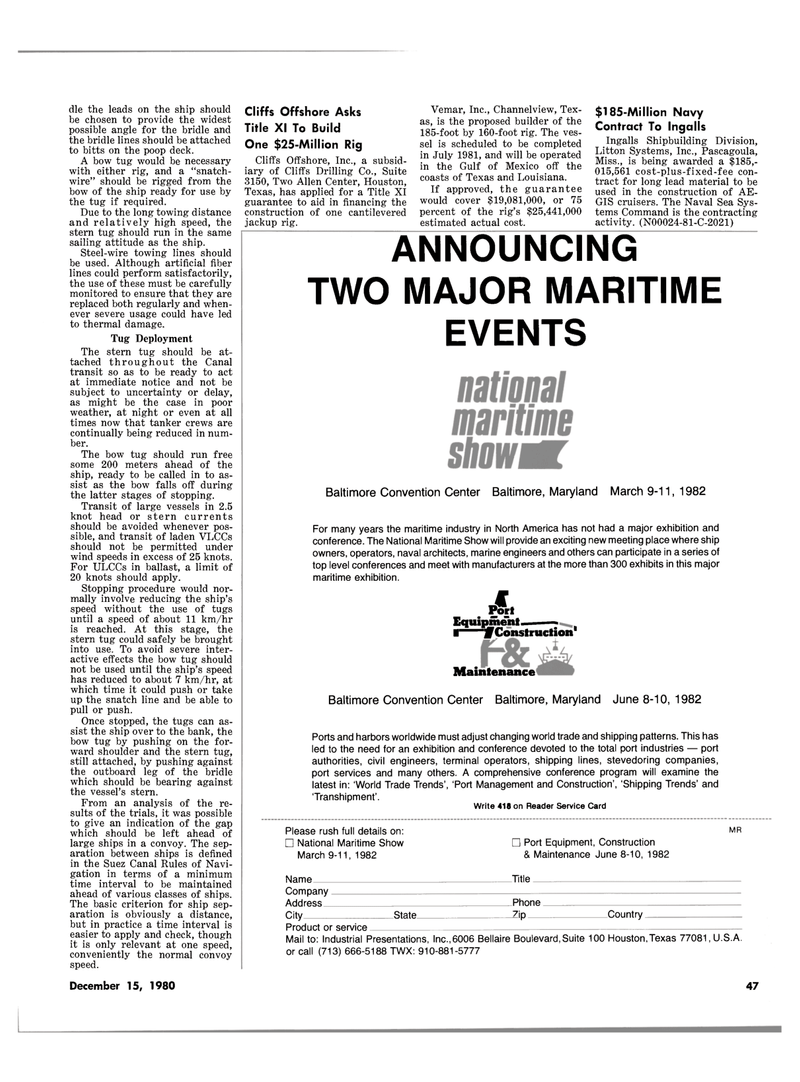
Page 43: of Maritime Reporter Magazine (December 15, 1980)
Read this page in Pdf, Flash or Html5 edition of December 15, 1980 Maritime Reporter Magazine
die the leads on the ship should be chosen to provide the widest possible angle for the bridle and the bridle lines should be attached to bitts on the poop deck.
A bow tug would be necessary with either rig, and a "snatch- wire" should be rigged from the bow of the ship ready for use by the tug if required.
Due to the long towing distance and relatively high speed, the stern tug should run in the same sailing attitude as the ship.
Steel-wire towing lines should be used. Although artificial fiber lines could perform satisfactorily, the use of these must be carefully monitored to ensure that they are replaced both regularly and when- ever severe usage could have led to thermal damage.
Tug Deployment
The stern tug should be at- tached throughout the Canal transit so as to be ready to act at immediate notice and not be subject to uncertainty or delay, as might be the case in poor weather, at night or even at all times now that tanker crews are continually being reduced in num- ber.
The bow tug should run free some 200 meters ahead of the ship, ready to be called in to as- sist as the bow falls off during the latter stages of stopping.
Transit of large vessels in 2.5 knot head or stern currents should be avoided whenever pos- sible, and transit of laden VLCCs should not be permitted under wind speeds in excess of 25 knots.
For ULCCs in ballast, a limit of 20 knots should apply.
Stopping procedure would nor- mally involve reducing the ship's speed without the use of tugs until a speed of about 11 km/hr is reached. At this stage, the stern tug could safely be brought into use. To avoid severe inter- active effects the bow tug should not be used until the ship's speed has reduced to about 7 km/hr, at which time it could push or take up the snatch line and be able to pull or push.
Once stopped, the tugs can as- sist the ship over to the bank, the bow tug by pushing on the for- ward shoulder and the stern tug, still attached, by pushing against the outboard leg of the bridle which should be bearing against the vessel's stern.
From an analysis of the re- sults of the trials, it was possible to give an indication of the gap which should be left ahead of large ships in a convoy. The sep- aration between ships is defined in the Suez Canal Rules of Navi- gation in terms of a minimum time interval to be maintained ahead of various classes of ships.
The basic criterion for ship sep- aration is obviously a distance, but in practice a time interval is easier to apply and check, though it is only relevant at one speed, conveniently the normal convoy speed.
Cliffs Offshore Asks
Title XI To Build
One $25-Million Rig
Cliffs Offshore, Inc., a subsid- iary of Cliffs Drilling Co., Suite 3150, Two Allen Center, Houston,
Texas, has applied for a Title XI guarantee to aid in financing the construction of one cantilevered jackup rig.
Vemar, Inc., Channelview, Tex- as, is the proposed builder of the 185-foot by 160-foot rig. The ves- sel is scheduled to be completed in July 1981, and will be operated in the Gulf of Mexico off the coasts of Texas and Louisiana.
If approved, the guarantee would cover $19,081,000, or 75 percent of the rig's $25,441,000 estimated actual cost. $185-Million Navy
Contract To Ingalls
Ingalls Shipbuilding Division,
Litton Systems, Inc., Pascagoula,
Miss., is being awarded a $185,- 015,561 cost-plus-fixed-fee con- tract for long lead material to be used in the construction of AE-
GIS cruisers. The Naval Sea Sys- tems Command is the contracting activity. (N00024-81-C-2021)
ANNOUNCING
TWO MAJOR MARITIME
EVENTS
Baltimore Convention Center Baltimore, Maryland March 9-11, 1982
For many years the maritime industry in North America has not had a major exhibition and conference. The National Maritime Show will provide an exciting new meeting place where ship owners, operators, naval architects, marine engineers and others can participate in a series of top level conferences and meet with manufacturers at the more than 300 exhibits in this major maritime exhibition.
A Equipment-
I ^Construction* Hr&ik
Maintenance
Baltimore Convention Center Baltimore, Maryland June 8-10, 1982
Ports and harbors worldwide must adjust changing world trade and shipping patterns. This has led to the need for an exhibition and conference devoted to the total port industries — port authorities, civil engineers, terminal operators, shipping lines, stevedoring companies, port services and many others. A comprehensive conference program will examine the latest in: 'World Trade Trends', 'Port Management and Construction', 'Shipping Trends' and 'Transhipment'.
Write 418 on Reader Service Card
Please rush full details on: MR • National Maritime Show • Port Equipment, Construction
March 9-11, 1982 & Maintenance June 8-10, 1982
Name Title
Company
Address Phon
City State Zip Country.
Product or service _
Mail to: Industrial Presentations, Inc.,6006 Bellaire Boulevard,Suite 100 Houston,Texas 77081, U.S.A. or call (713) 666-5188 TWX: 910-881-5777
December 15, 1980 47

 42
42

 44
44
